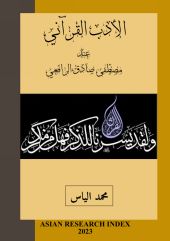تقریظ دوئم
بسم اللہ الرحمن الرحیم
نحمدہٗ و نصلی علی رسولہِ الکریم
زیر نظر کتاب ’’ نگارشاتِ راشد‘‘ کی ورق گردانی کرتے ہوئے مختلف مقامات پر بنظر تعمق توجہ کی جس کو پڑھ کر انتہائی مسرّت ہوئی کہ حافظ محمد اکرم راشدؔنے انتہائی محنت، لگن اور خدمتِ خلق کے جذبہ سے سرشار ہو کر عوام النّاس کے لیے بالعموم اور طلباء کے لیے بالخصوص مقالات کے مجموعہ کو’’ نگارشات راشد‘‘ کے عنوان سے مُدّون کیا۔ جس کی عصرِ حاضر میں بہت ضرورت ہے ۔ اِن تقریروں اور تحریروں کے مجموعہ سے طلباء کو مضمون اور تقریر کے تیار کرنے میں کوئی دقت پیش نہ آئے گی۔ موصوف نے اپنی اِن تحریروں کے ذریعے ترغیبی انداز اختیار کرتے ہوئے دینی نقطۂ نظر سے بھی شائقین مطالعہ کی راہنمائی کی ہے ۔ یہ طلباء کے لیے ایک انمول تحفہ ہے ۔ تحریر میں جامعیت، اختصار ، مناسبت ، روانی اور مقفّع و مسجّع عبارتیں موصوف کی اِس فن سے آشنائی پر دَال ہیں ۔ ؎ اللہ کرے زورِ قلم اور زیادہ!
یہ گزارشاتِ راشد
یہ سفارشاتِ راشد
حکمت کا ہیں خزینہ
یہ نگارشاتِ راشد
امین بجاہ سید المرسلین
پروفیسر اکرام تائب
سابق صدر شعبہ (ادبیات اردو)
گورنمنٹ پوسٹ گریجو ایٹ کالج ،عارفوالا
Ijmaa is the fourth source of Islamic law. It is the product of collective Ijthihad of Islamic jurists. This is one of the principal source of Islamic law and is based on the Qur'an and Sunna. It is in a way a kind of Ijthihad and can be termed as a collective Ijthihad. In modern day it can be exercised through parliament or a committee on Ijthihad. Its scope can be further widened for the Umma through an international council or congress of Islamic scholars.
Bacillus α-amylases are widely used in industrial processes. Nevertheless, there is a need to improve the temperature tolerance of α-amylases as high temperature conditions are used in many industrial processes. In this study, various isolates of Bacillus licheniformis (B. licheniformis) were recovered from soil using potatoes (Solanum tumberosum) and sweet potatoes (Ipoema batatas) for baiting. Isolates were identified using common morphological techniques and biochemical tests with an API kit. B. licheniformis isolates for further study were selected on the basis of high α-amylase production. The α-amylase gene was cloned in plasmid pTBSG1 and characterized. Mutations to be introduced for enhancing α-amylase stability were predicted by in-silico design using various computational tools: Rosetta, the disulfide design server and the RosettaVIP tool. The disulfide design server identified five double mutants for mutagenesis to cysteine residues as follows: L64C/K80C, E119C/S130C, G433C/G474C, T139C/W157C and Y396C/D416C. A sixth mutant, V283I, was predicted with the RosettaVIP tool. The various mutants were prepared with the Phusion site-directed mutagenesis kit with the help of modified primers. Wild-type and mutants were then recombinantly expressed in E. coli BL21 (DE3) and characterized and compared to wild-type enzyme. Wild-type and mutant enzymes were pre-incubated at 45 ºC to 85 ºC and residual activities were found to not vary significantly till 55 ºC (P-value > 0.05). On the other hand, at 65 ºC, 75 ºC and 85 ºC, mutant V283I showed significantly improved thermostability (P-value < 0.05). Among the double mutants, G433C/G474C was found to have highest thermostability in terms of thermal inactivation (P < 0.05). This study shows that the rational design and introduction of substitution mutations leading to the formation of disulfide bonds and increased hydrophobic interactions has high potential for improving the thermal stability of α-amylases.



